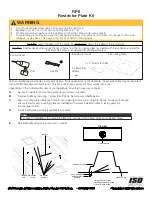
16
If a chimney or creosote
fi
re occurs, close all dampers immediately. Wait for the
fi
re to go out and the heater to cool, then inspect the chimney
for damage. If no damage results, perform a chimney cleaning to ensure there is no more creosote deposits remaining in the chimney.
OPERATIONAL TIPS
Operational Tips for Good, Ef
fi
cient, and Clean Combustion
•
Get the appliance hot and establish a good coal bed before adjusting to a low burn rate (this may take 30 minutes or more depending on
your wood)
•
Use smaller pieces of wood during start-up and a high burn rate to increase the stove temperature
•
Be considerate of the environment and only burn dry wood
•
Burn small, intense
fi
res instead of large, slow burning
fi
res when possible
•
Learn your appliance’s operating characteristics to obtain optimum performance
•
Burning unseasoned wet wood only hurts your stoves ef
fi
ciency and leads to accelerated creosote buildup in your chimney.
ASH DISPOSAL
Whenever ashes get 3 to 4 inches deep in your
fi
rebox or ash pan, and when the
fi
re has burned down and cooled, remove excess ashes. Leave
an ash bed approximately 1 inch deep on the
fi
rebox bottom to help maintain a hot charcoal bed.
Ashes should be placed in a metal container with a tight-
fi
tting lid. The closed container of ashes should be placed on a noncombustible
fl
oor or
on the ground, away from all combustible materials, pending
fi
nal disposal. The ashes should be retained in the closed container until all cinders
have thoroughly cooled.
It is strongly recommended that ashes in the metal container are taken outside immediately, and are not stored within your home.
SMOKE AND CO MONITORS
Burning wood naturally produces smoke and carbon monoxide(CO) emissions. CO is a poisonous gas when exposed to elevated concentrations
for extended periods of time. While the modern combustion systems in heaters drastically reduce the amount of CO emitted out the chimney,
exposure to the gases in closed or con
fi
ned areas can be dangerous. Make sure you stove gaskets and chimney joints are in good working order
and sealing properly to ensure unintended exposure. It is recommended that you use both smoke and CO monitors in areas having the potential to
generate CO. MAINTENANCE
Your wood stove is a high ef
fi
ciency stove and therefore requires little maintenance. It is important to perform a visual inspection of the stove
every time it is emptied, in order to insure that no parts have been damaged, in which case repairs must be performed immediately. Inspect and
clean the chimney and connector pipe periodically for creosote buildup or obstructions.
GLASS
•
Inspect and clean the glass regularly in order to detect any cracks. If you spot one, turn the stove off immediately. Do not abuse the glass door
by striking or slamming shut. Do not use the stove if the glass is broken.
•
If the glass on your stove breaks, replace only with the glass supplied from your heater dealer. Never substitute other materials for the glass.
•
To replace the glass, remove the screws retaining the glass mouldings inside the door. Remove the mouldings and replace the damaged piece
with a new one. Perform the procedure backwards after replacing. When replacing the glass, you should change the glass gasket to make sure
you keep it sealed.
•
Never wash the glass with a product that may scratch. Use a specialized product, available in the stores where wood stoves are sold. The
glass should be washed only when cold.
GASKETING
It is recommended that you change the door gasket (which makes your stove door air tight) once a year, in order to insure good control over the
combustion, maximum ef
fi
ciency and security. To change the door gasket, simply remove the damaged one. Carefully clean the available gasket
groove, apply a high temperature silicone sold for this purpose, and install the new gasket. You may light up your stove again approximately 24
hours after having completed this operation. This unit’s door uses a 3/4” diameter rope gasket.
WARNING:
•
NEVER OPERATE THE STOVE WITHOUT A GASKET OR WITH A BROKEN ONE. DAMAGE TO THE STOVE OR EVEN HOUSE
FIRE MAY RESULT.
PAINT
Only clean your stove with a dry soft cloth that will not harm the paint
fi
nish. If the paint becomes scratched or damaged, it is possible to give
your wood stove a brand new look, by repainting it with a 1200° F heat resistant paint. For this purpose, simply scrub the surface to be repainted
with
fi
ne sand paper, clean it properly, and apply thin coats (2) of paint successively.
AIR TUBES
The air tubes assembled in this unit are designed to provide an accurate mix of secondary air to insure the highest ef
fi
ciency. Any damage or
deterioration of these tubes may reduce the ef
fi
ciency of combustion. The air tubes are held in position by either screws or snap pins. Locate these
to either side of the tube and remove to allow the tube to be removed and replaced.









































